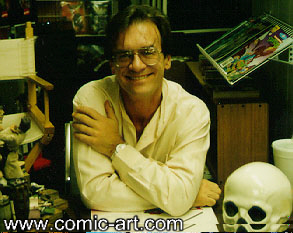
Museum of Comic Art | Search this Site | Web Links
About Comic-art.com | Art For Sale | Comics For Sale
Comics On CDRom | Movie Posters | Pulps For Sale
We Buy Collections | Contact Us |Home Page

| Berni Wrightson | ||
|
||
|
Then in 1967, the 23 year old artist went to a comic book convention in New York where he met future studio mates Mike Kaluta and Jeff Jones, as well as the man many, including Wrightson, attribute as their greatest influence - Frank Frazetta. By this time he had become a big fan of the Warren magazines, Creepy and Eerie, largely because of their similarity to EC. As a matter of fact he had a small "fan" illustration published in Creepy #9, and when he returned home from his trip to New York, Bernie began to draw comics again, doing a story called "Uncle Bill's Barrel" which was published in a comics fanzine. In July 1968 Bernie went back to New York to attend the first Phil Seuling Comic Art Convention at the Statler Hilton hotel, where he met DC editor Dick Giordano. He showed Giordano copies of Uncle Bill's Barrel and got a job at DC. |
||
|
||
|
The Swamp Thing. That was the name of the book. It featured a character who had been transformed from a man into a giant Hulk-like mass of swamp muck. It was quite simply put, a runaway smash hit, and Bernie had hit the big time. He did just ten issues, but these ten books are acknowledged as some of the most revolutionary comics of all time. By this time Bernie's art had fully developed into what became the quintessential look of horror comic art at the time. The slim lines and finely detailed panels were reminiscent particularly of Graham Ingels EC work, but also infused with influence by Frank Frazetta, Wally Wood, Jack Kirby and the cinematic design of Milton Caniff. Bernie was on his way to becoming an icon on his own. By 1974 Bernie had secured work at Warren, where he was to do a series of horror stories of such high quality that being printed in black and white may have been a benefit to printing the artwork. He did a few Edgar Allan Poe adaptations and some H.P. Lovecraft adaptations as well as a few original stories. Actually he did quite a number of them. Then he did a number of inside cover pieces featuring Cousin Eerie & Uncle Creepy. This artwork was of superior quality also and the pieces are highly sought after by collectors. All during this period he was also doing art for publication as posters and art prints, calendars and coloring books. he did a number of artist's portfolios and paintings. Many of these pieces were done for Christopher Zavisa "Christopher Enterprises". Zavisa became very closely associated with Wrightson, and over the course of the three years of their relationship, Bernie did many of his best pieces. During the next phase in his career he was to work for several years on a project that had always been close to his heart. Bernie had read Mary Shelley's "Frankenstein" as a teen and loved the story. He had drawn images of the monster for years. Some of them exist on the backs of comic pages. He began in earnest on illustrating the legendary novel for Christopher Enterprises, but Zavisa sold his interest in the company to his partner in 1978, and within a few months the company was run down and forced into bankruptcy, putting the project on hold until Bernie could find someone else to publish the book. |
||
|
||
|
Another project published in 1983 was Stephen King's "Cycle of the Werewolf" (published by Zavisa) for which Wrightson drew a number of color plates. He did a number of projects in Hollywood including designing many conceptuals for the Ghostbusters movie, from the devil dogs to the gates of hell. In more recent years, Bernie has done so much work it is difficult to recount it all. Comic books, graphic novels, gum card sets, posters, and on and on. Bernie Wrightson is without question one of the very top artists of his generation, having developed into possibly one of the best illustrators of the latter part of the twentieth century. He has influenced many of today's current artists of which Simon Bisley and Kelley Jones are two of the most successful emulators. This writer for one has always been a big fan of his and can't wait to see what he does next.. |
||
 |
||
|
|
||

 |
 |